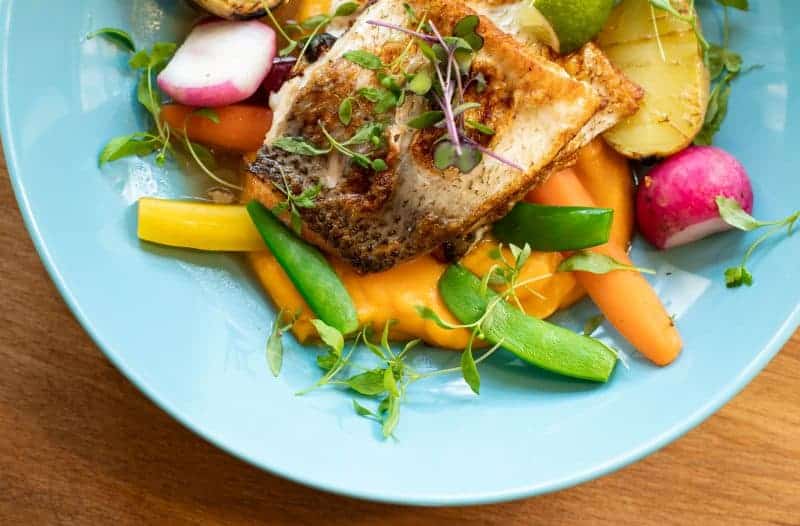Ultimate Croatia Wine Travel Guide

Embark on a wine lover’s dream journey to Croatia, a country with a rich viticultural history, stunning landscapes, and a vibrant wine scene. Welcome to our comprehensive guide to wine travel in Croatia. Join us as we explore the rich history, diverse wine regions, unique Croatian wines and grape varieties, top wineries to visit, the best wine hotels to stay at, and tips for traveling through Croatia to experience its wine culture at its best.
The historical significance of Croatian wines
It’s not only Croatia’s scenic beauty that captivates visitors; it’s also the rich history of Croatian wine and its deeply-rooted old-world wine culture.
From ancient times to present, Croatia’s vineyards have produced exceptional wines that offer a taste of the past and a glimpse into the country’s wine-making heritage.
Ancient beginnings
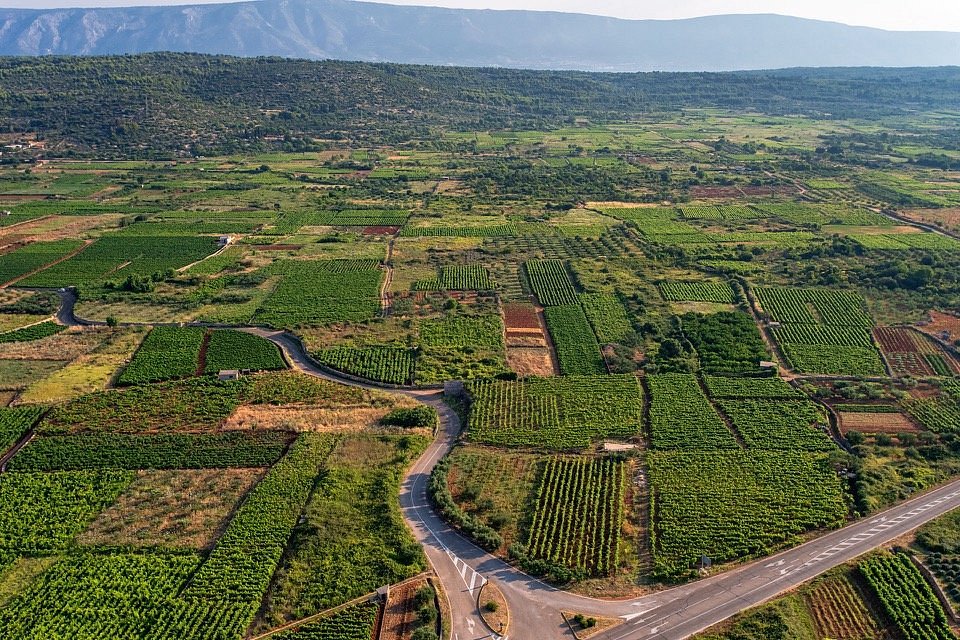
Croatia’s winemaking history dates back thousands of years to the time of the Illyrians and the ancient Greeks who settled along the coast.
These civilizations recognized the region’s potential for cultivating vines and producing wine. The Greeks even named one of Croatia’s islands, Issa (now Vis Island), the “Land of Wine.”
The Stari Grad Plain, located near Stari Grad on the island of Hvar, is an agricultural landscape with significant historical and cultural value.
This plain was established by ancient Greek colonists in the 4th century BC and has remained remarkably well-preserved over the centuries.
The landscape has a unique land use system and agricultural colonization set up by the Greeks, making it an exceptional example of early farming practices.
This cultural landscape has retained its original layout, including plots of land separated by dry-stone walls that were used for cultivating various crops.
The Stari Grad Plain has witnessed continuous agricultural activity throughout its history, with vineyards, olive groves, and fields for grain cultivation being characteristic features.
The area’s agricultural heritage is exemplified by its consistent use for farming over 2400 years, making it an exceptional testament to the endurance of traditional practices.
The Stari Grad Plain’s historical significance has earned it a place on the UNESCO World Heritage list, recognizing its exceptional value as a well-preserved example of ancient Greek agricultural practices and land organization.
Visitors can explore this unique cultural landscape along walking or cycling paths, immersing themselves in the historical and natural beauty of the island of Hvar.
The Roman Era
With the rise of the Roman Empire, the art of winemaking in Croatia reached new heights. The Romans recognized the fertile soils and favorable climate, which led to the expansion of vineyards and the introduction of advanced wine production techniques.
The legacy of the Roman influence on Croatian viticulture can still be observed today, as remnants of Roman amphorae used for wine storage have been discovered in various archaeological sites.
Over the centuries, various cultures and civilizations have influenced winemaking techniques, resulting in a unique blend of tradition and innovation.
Influence of old world wine culture
Croatia’s wine culture is firmly rooted in the traditions of the Old World. The country’s winemakers prioritize quality and terroir, valuing the unique characteristics the local environment imparts to the grapes.
This focus on the natural attributes of the land and the interaction between soil, climate, and grape varietals mirrors the approach of other renowned Old World wine regions like France, Italy, Germany and other.
Recognition and modern renaissance
While Croatia’s winemaking heritage persisted through the centuries, it was during the late 20th and early 21st centuries that Croatian wines began to garner international attention.
Indigenous grape varietals cultivated for generations were rediscovered and celebrated for their distinctiveness.
This recognition led to a modern renaissance in Croatian winemaking, with innovative winemakers combining traditional methods with contemporary techniques to produce exceptional wines that reflect both the past and the present.
Diverse Croatian wine regions
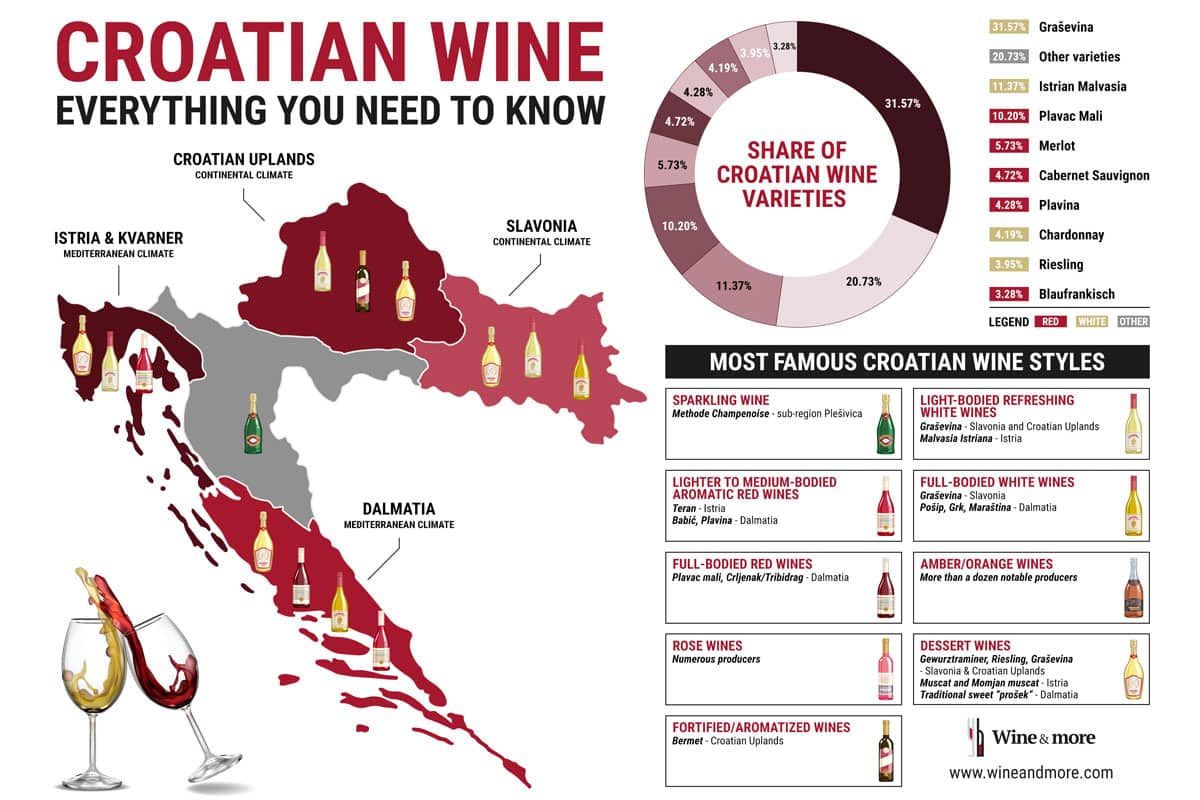
Croatia’s geography is a patchwork of microclimates and diverse terroirs, creating ideal conditions for a wide variety of grape cultivation. Some of the standout wine regions include:
- Istria and Kvarner wine region: Nestled along the western coast of Croatia, the Istria region is a true gem for wine lovers. Known for its stunning coastal vistas, rolling hills, and charming medieval towns, Istria offers a perfect climate for cultivating various grape varieties and some of Croatia’s best food and wine experiences. Malvazija Istriana and Teran are the standout local grape varieties here. Located between Istria and Dalmatia, the Kvarner region boasts unique microclimates that yield both white and red wines. Vrbnik on the island of Krk is famous for its indigenous Žlahtina variety.
- Dalmatia wine region: Heading south along the coast, Dalmatia, with its breathtaking coastline and must-visit historic cities like Zadar, Šibenik, Split and Dubrovnik, is a region where tradition seamlessly blends with innovation in winemaking. The iconic grape variety of Dalmatia is Plavac Mali, a red grape proven to be related to California’s Zinfandel (which originates from Croatia). This grape thrives in the arid climate, producing wines with a rich body, spicy notes, and a touch of Mediterranean herbs. The islands of Korčula, Brač, Hvar, Vis and Pelješac peninsula are renowned for their winemaking heritage, producing some of Croatia’s most celebrated wines.
- Slavonia and the Danube wine region: In the northeastern part of Croatia lies the vinicultural treasure of Slavonia and the Danube. With its continental climate and fertile plains, Slavonia is home to traditional grape varieties like Graševina, Frankovka, and Traminer.
- Croatian Uplands: As one ventures further inland, the wine regions of Continental Croatia come into play. Plešivica, Zagorje, Međimurje, Moslavina, and Prigorje are areas with diverse terroirs, allowing for the cultivation of a wide range of grape varieties. From sparkling wines in Plešivica, crisp Sauvignon Blancs, and Pušipel, to indigenous Kraljevina and Škrlet, these regions offer an exploration of flavors that reflect the country’s diverse topography.
Top 10 indigenous grape varieties

Deep-rooted in its cultural heritage lies an enigmatic world of 130 indigenous grape varieties that have been nurtured and cultivated for centuries, resulting in exceptional wines that are gaining recognition on the international stage.
Croatia’s diverse landscape is a mosaic of microclimates, terrains, and soil types. This geographical richness has given rise to a fascinating array of indigenous grape varieties. Each is uniquely adapted to its specific environment.
From the rolling hills of Croatian Uplands to the sun-drenched Dalmatian islands, Croatia’s grapevine-covered landscapes hold a treasure trove of vinicultural diversity.
Croatia is home to an impressive array of indigenous grape varieties, contributing to the country’s distinct winemaking identity. Some noteworthy examples include:
- Plavac Mali: Hailing from the Dalmatian region, Plavac Mali stands as Croatia’s most celebrated grape variety. Known as the “King of Croatian Red Wines,” Plavac Mali is a robust red grape variety cultivated primarily along the Dalmatian coast.Plavac Mali wines exhibit dark fruit notes, hints of Mediterranean herbs, and often a smoky undertone, making them perfect companions for hearty meat dishes. Renowned for its bold flavors and rich tannins, this grape is the offspring of the native Dobričić and Zinfandel, showcasing a unique connection to its heritage.
- Malvasia Istriana: Venture to the Istrian peninsula, and you’ll encounter Malvasia Istriana, a white grape variety that has been cultivated for centuries. This aromatic gem produces wines with floral and fruity notes, often accompanied by a pleasant bitterness. Its versatility shines through in various styles, from fresh and zesty to complex and oak-aged, making it a favorite among both local winemakers and international enthusiasts.
- Graševina: Also known as Welschriesling, Graševina is Croatia’s most widely planted white grape variety. It flourishes in the continental climate of Slavonia and the Danube wine region and produces mainly crisp and refreshingly vibrant wines with floral and fruity aromas. Graševina wines are exceptionally versatile and can be enjoyed as a refreshing aperitif or paired with various dishes. This variety has been a staple in the region for generations, and its adaptability to different winemaking techniques has enabled winemakers to craft an impressive range of styles, from dry and mineral-driven to late-harvest dessert and even ice wines.
- Pošip: The island of Korčula in the Adriatic Sea is homeland of the Pošip grape, which produces white wines characterized by their full body and pronounced fruitiness. As one of Croatia’s most popular white stars, Pošip has garnered attention for its ability to capture the essence of its Mediterranean island terroir. Indigenous to the island of Korčula but planted along the Dalmatian coast, Pošip is a white grape variety that creates elegant and aromatic wines. With its pronounced floral and stone fruit notes, Pošip wines capture the essence of the Mediterranean.
- Babić: Grown primarily in the region of northern Dalmatia, Babić is a red grape variety known for its deeply colored and robust wines. These wines exhibit dark berry flavors, herbal undertones, and a touch of spice. Babić wines pair harmoniously with grilled meats, stews, and Mediterranean cuisine.
- Grk: Hailing from the island of Korčula, Grk is a unique white grape variety known for its distinctive small, round clusters and high acidity. Grk wines offer intriguing citrus and almond notes, making them an interesting match for seafood and shellfish.
- Teran: Native to the Istrian peninsula, Teran is a red grape variety that thrives in the region’s iron-rich red soils. Teran wines are recognized for their vibrant acidity, bold red fruit flavors, and distinctive earthy notes. This makes them a fantastic match for cured meats, game dishes, and aged cheeses.
- Debit: Debit is a white grape variety found predominantly in the Dalmatian region. Its wines are known for their crisp acidity, light body, and delicate citrus and green apple flavors. Debit wines make for a refreshing choice on warm summer days and are often enjoyed with light salads and seafood.
- Plavina: Indigenous to the Dalmatian coast, Plavina is a red grape variety that produces wines with a medium body and a pleasant balance between red fruit flavors and herbal nuances. Plavina wines are a great companion for Mediterranean fare, particularly grilled vegetables and pasta dishes.
- Žlahtina: Cultivated on the island of Krk, Žlahtina is a white grape variety that yields light and crisp wines with subtle floral aromas and hints of green apple. Its refreshing character makes it a popular choice as a companion for seafood, salads, and light appetizers.
While their names may be difficult to pronounce to non-Croats 🙂 the indigenous grape varieties of Croatia serve as more than just key components in creating exceptional wines. These grapes represent the rich history and cultural identity of the country’s winemaking.
In recent years, there has been a revitalized effort to preserve these precious varieties, often at risk of extinction due to the allure of more internationally recognized grapes.
Local winemakers, supported by passionate enthusiasts, are championing the cause of these indigenous varieties, allowing them to flourish once again.
Award-winning wines
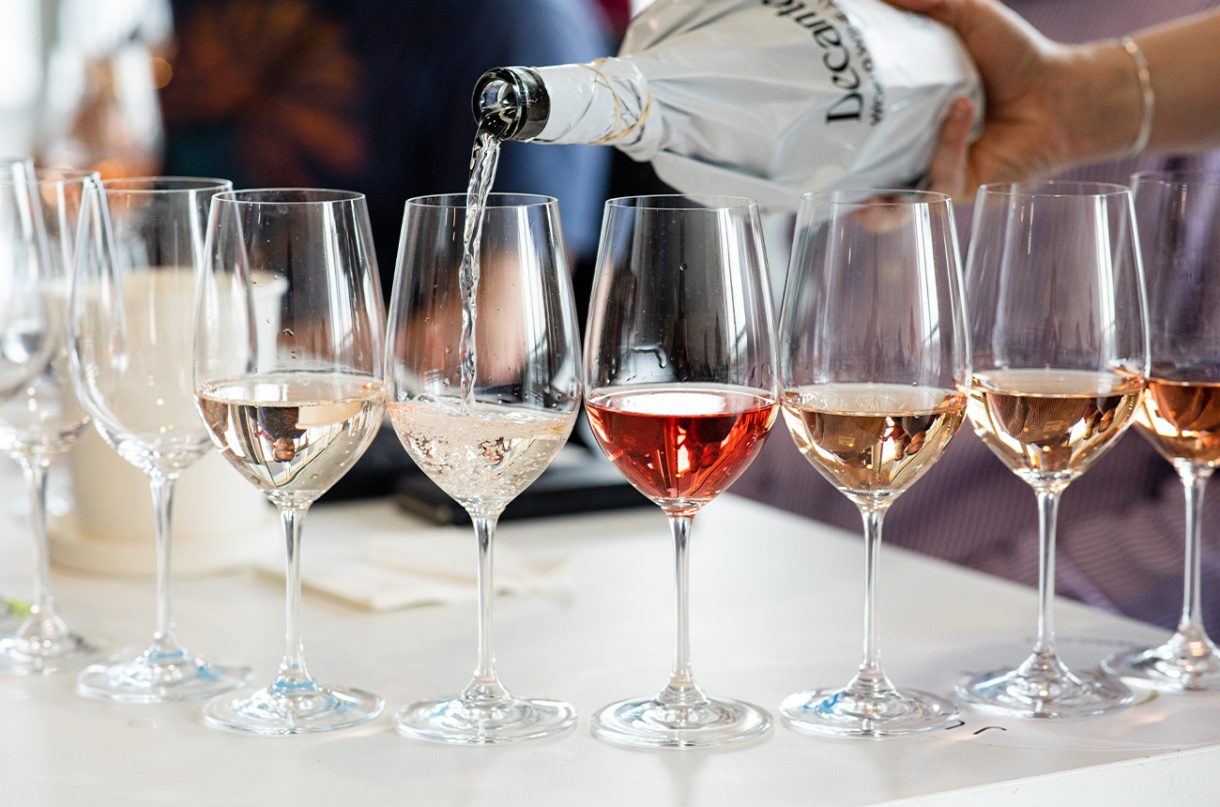
In recent decades, Croatian wines have gained international recognition, winning accolades and awards in renowned wine competitions and critics and earning spotlight in the iconic wine magazines.
As global wine appreciation continues to expand, Croatia’s indigenous grape varieties and wines are finding their place on the international stage.
We have recently opened a new category of wines called “awarded wines” due to the high demand. You can now easily find and choose your new favorite bottle of awarded Croatian wine. 🙂
Wine enthusiasts and sommeliers are increasingly drawn to the uniqueness and authenticity of these varieties, appreciating the connection they offer to Croatia’s rich history and distinct terroirs.
However, the charm of Croatia goes beyond the quality of its wines. It’s also about the immersive experience of exploring centuries-old vineyards, meeting passionate winemakers, and enjoying the local cuisine that complements the wines so perfectly.
Must-visit Croatian wineries
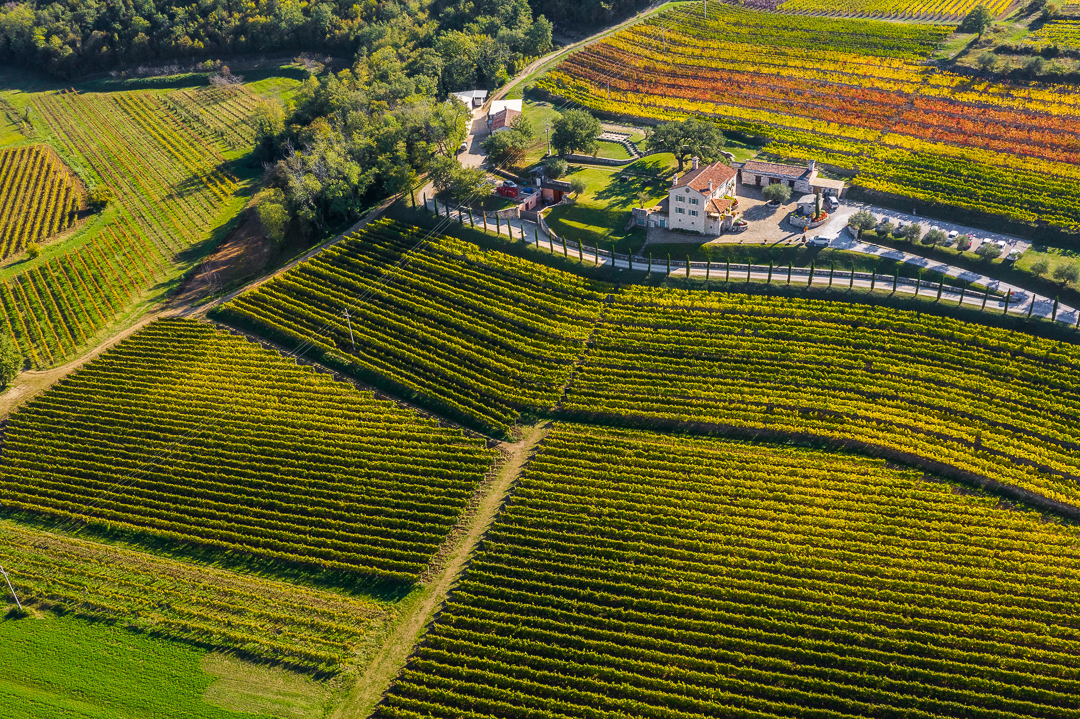
Croatia’s winemaking heritage is a journey through time and terroir. From the sun-kissed vineyards of Pelješac Peninsula to the charming wineries of Istria, each destination and winery offers a distinctive experience that combines history, tradition, and innovation.
When planning your Croatian wine adventure, check our essential guide to Croatian wineries or simply list one of these wineries that should undoubtedly be at the forefront of your list.
- Kozlović Winery, Istria: Known for its elegant Malvasia and Teran wines, Kozlović Winery offers guided tours through its vineyards and a chance to savor wines in a picturesque setting.
- Kabola Winery, Istria: Situated in the Istrian region, specifically in the village of Momjan, Kabola Winery has a rich history of producing high-quality wines. The winery is recognized for its commitment to organic winemaking practices, emphasizing a natural and sustainable approach.
- Roxanich Winery, Istria: Not just a winery, Roxanich is an experience in itself. Located near historic Motovun town, it combines organic winemaking with a commitment to preserving local heritage. The winery’s ‘orange wines’ are particularly noteworthy, providing a distinct taste of the region.
- Coronica Winery, Istria: Coronica Winery, another gem in Istria, is known for its dedication to indigenous grape varieties such as Malvasia Istriana and Teran. The winery’s terra rossa, or red soil vineyards, add a touch of uniqueness to the tasting experience of their wines.
- Benvenuti Winery, Istria: Benvenuti Winery, located in the heart of Istria, is celebrated for its exceptional Malvasia and Teran wines. The family-owned winery focuses on organic practices, allowing the true flavors of the Istrian terroir to shine through in each glass.
- Bibich Winery, Skradin: Nestled in the historic town of Skradin, Bibich Winery is famous for its innovative winemaking techniques. The owner, Alen Bibić, is celebrated for his experimental approach, resulting in exceptional blends that pay homage to tradition while embracing modernity.
- Stina Winery, Brač Island: Nestled on the picturesque Brač Island, Stina Winery showcases an impressive collection of wines crafted from local grape varieties, including Plavac Mali and Pošip. The winery’s modern architecture seamlessly blends with the island’s natural beauty, creating a unique atmosphere for wine tasting.
- Korta Katarina Winery, Pelješac Peninsula: Renowned for its Plavac Mali wines, Korta Katarina Winery offers breathtaking views of the Pelješac Peninsula’s coastline. With a focus on small production and attention to detail, their wines capture the essence of the region’s terroir.
- Saints Hills Winery, Pelješac Peninsula: Situated on the Pelješac Peninsula, Saints Hills Winery offers an idyllic setting. With a focus on sustainability and organic practices, their wines reflect the region’s diverse terroir.
- Grgić Winery, Pelješac Peninsula: Founded by the legendary winemaker Miljenko “Mike” Grgich, this winery brings a touch of Napa Valley expertise to Croatian winemaking. Grgić Vina is renowned for its elegant wines, especially the Plavac Mali-based offerings.
- Ilok Cellars, Ilok: Moving to the eastern part of Croatia, Iločki Podrumi is one of the oldest wineries in the country, dating back to the 15th century. Known for its Traminac (Gewürztraminer) wines, the winery’s underground cellars are a testament to centuries of winemaking tradition.
- Kutjevo Winery, Kutjevo: The oldest winery in Croatia holds a rich history in winemaking dating back to its establishment in 1232 by Cistercian monks. The winery is renowned for the production of high-quality wines. Specializing in the Graševina grape variety, the winery has garnered numerous awards and recognitions, making it a prominent figure and one of the biggest exporters of Croatian wine.
- Enosophia Winery, Feričanci: The winery is known for embodying the wisdom of wine through its passion and dedication to winemaking. With a strong emphasis on tradition and creativity, Enosophia produces a range of sparkling, white and red wines that offer an immersive and sensory experience.
- Korak Winery, Plešivica: A renowned family-owned winery located amidst the picturesque Plešivica vineyards, the winery holds deep roots in the area, dating back to the 4th and 5th generations of the family. This prestigious establishment is not only recognized for its exceptional wines but also for its Michelin Star restaurant. The winery’s commitment to the Plešivica region is evident in its passion for the land and its devotion to producing high-quality wines.
- Štampar Winery, Sveti Urban: Renowned winery located in Štrigova, and established over a century ago in 1913. The winery has a rich history of producing high-quality wines in the Međimurje winegrowing region and is known for its exceptional still white wines that are characterized by their unique freshness, exceptional aroma, and varietal purity.
Where to stay in Croatia?
This charming country is home to some of the world’s finest wine hotels and winery stays.
These places offer a perfect combination of luxurious wine hotels and winery accommodations, exquisite dining, and a chance to experience the rich winemaking traditions that have been passed down for generations.
What could be more enjoyable than immersing yourself in a delightful combination of natural beauty and cultural traditions while staying at one of the top wine hotels in the country?
Meneghetti Wine Hotel & Winery
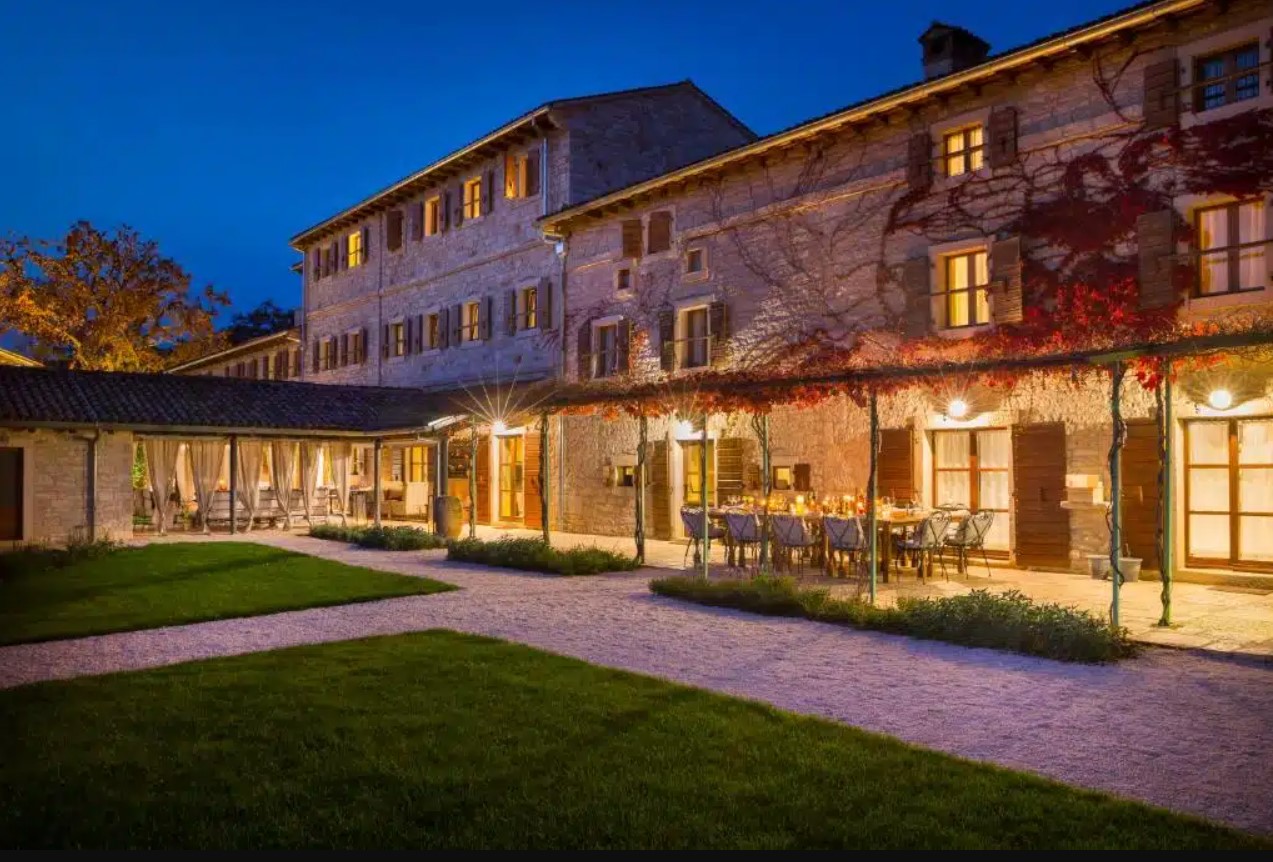
Nestled in the heart of Istria, the Meneghetti Wine Hotel & Winery stands as a testament to luxury and viticulture.
This elegant estate is an exquisite 19th-century villa meticulously restored into a boutique hotel. The property’s vineyards produce top-quality Malvasia and Teran grapes, which are transformed into outstanding wines.
Guests can indulge in wine tastings, guided tours of the vineyards, and even participate in harvest activities during the grape season.
Don’t miss out on tasting wines, such as
- Meneghetti Red,
- Black label Malvazija, or their
- exquisite sparking Meneghetti Classic.
Wine enthusiasts will be in heaven with the highly coveted Meneghetti wine collection available.
Roxanich Winery and Design Hotel
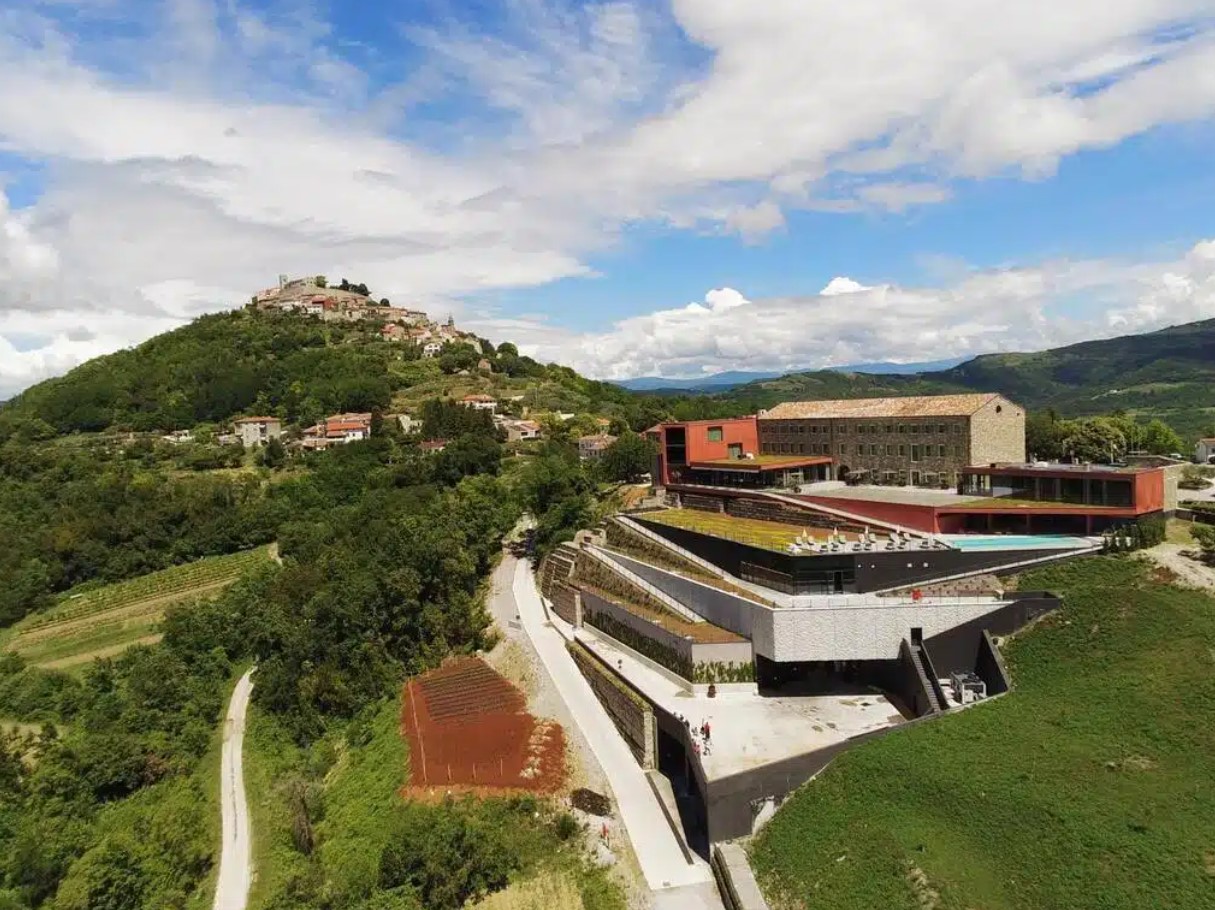
Roxanich Winery and Design Hotel is an artisan winery and luxury hotel located in Motovun.
The winery specializes in producing rare, long-aged, and natural wines.
Situated on an Istrian hillside, the hotel features modern architecture complemented by vibrant interior design.
The hotel offers a variety of 32 exquisitely designed rooms and suites, providing guests with a luxurious and comfortable stay.
In addition to its accommodations, Roxanich Winery and Design Hotel offers fine dining experiences that highlight the region’s local flavors and ingredients.
The establishment provides wine tastings, allowing visitors to sample their exclusive wines and learn about the winemaking process.
Take a magnificent tour of the five floors and underground wine cellar of Roxanich Winery, where you can indulge in their skillfully aged wines like Roxanich Superistrian or other Roxanich selected wines.
Winery Cuj Bed & Breakfast

Winery Cuj Bed & Breakfast is a charming accommodation located in the village of Vilanija in the Istria region.
This bed and breakfast offers a peaceful retreat surrounded by vineyards and olive trees, making it an ideal destination for wine and nature enthusiasts.
The Winery Cuj Bed & Breakfast provides well-appointed accommodations with plenty amenities.
The guests have access to a garden where they can relax and enjoy the natural surroundings.
Cuj Winery, is also known for producing quality wines and olive oils. Visitors can explore the winery, taste their wines, and enjoy the serene atmosphere of the surrounding countryside.
With its proximity to Umag and its beaches, the location provides a convenient base for travelers looking to explore the region.
Cattunar Wine Residence
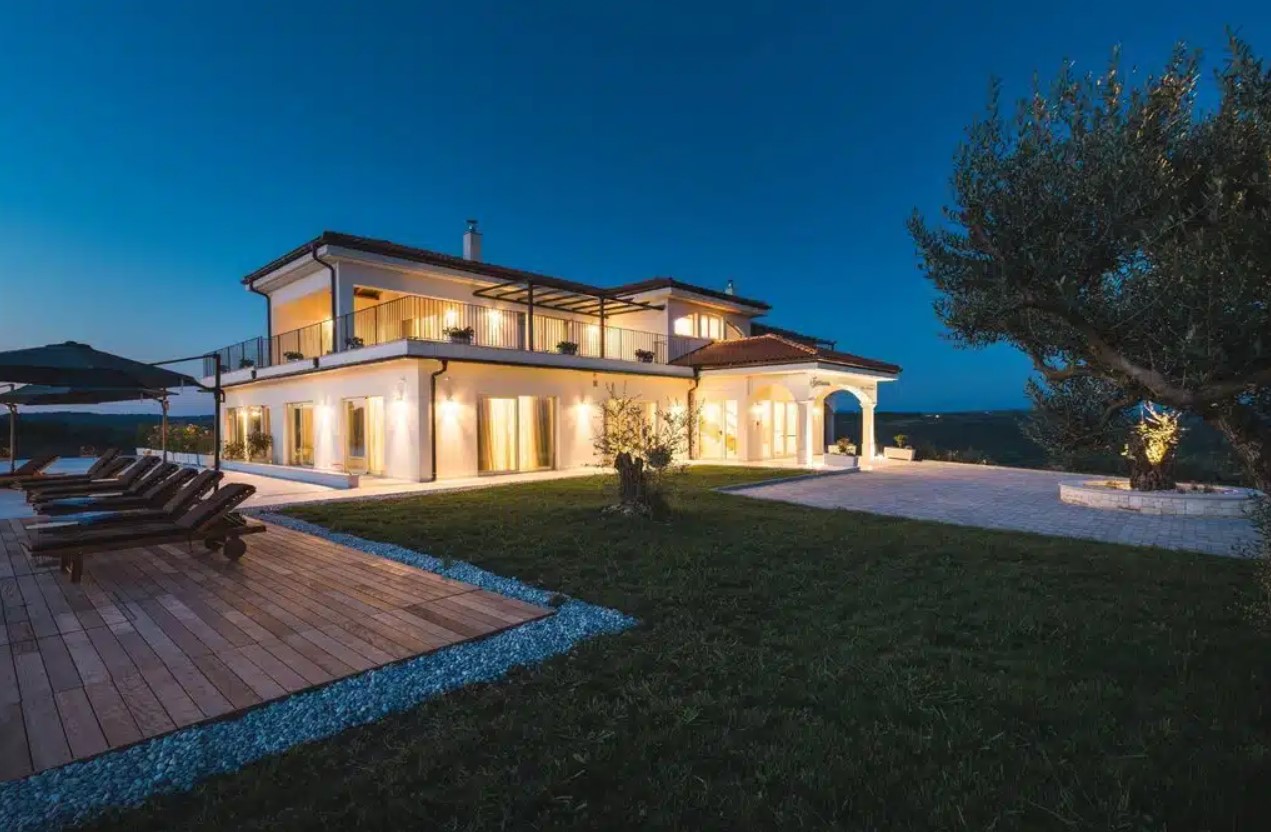
Cattunar Wine Residence is a luxurious villa located amidst the picturesque Cattunar vineyards in Brtonigla in Istria.
This exquisite residence offers a tranquil escape in the heart of the most vibrant part of Istria.
With 11 beautifully appointed spacious rooms ranging from 40 to 70 square meters, each featuring large terraces, guests can indulge in comfort and relaxation.
The villa is conveniently situated just minutes away from the coastline, the Aquapark Istralandia, and the charming coastal tourist destinations.
The Cattunar Wine Residence provides an idyllic setting for travelers seeking a peaceful oasis.
Guests have the opportunity to immerse themselves in the serene atmosphere of the vineyards and enjoy the natural beauty of the surrounding area.
The family-owned Cattunar estate has created a haven where guests can unwind and experience the essence of Istria’s wine culture.
The property also offers amenities such as free bikes for exploring the nearby attractions and private parking for guests.
Boutique Hotel and Winery Boškinac
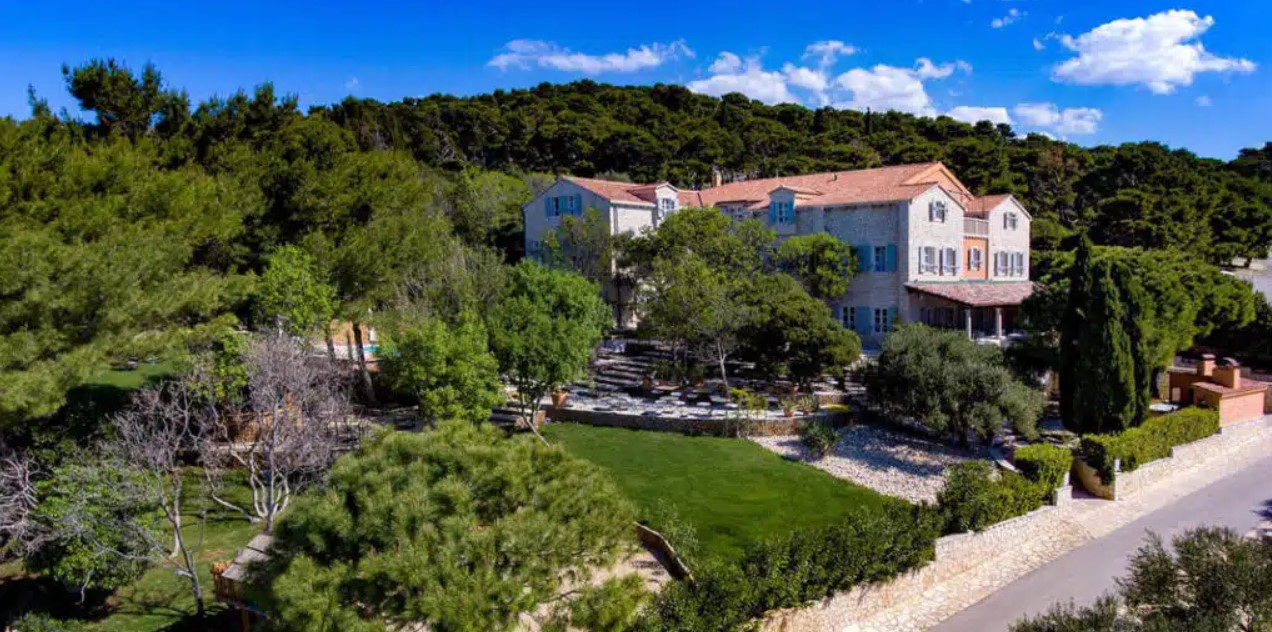
Located on the island of Pag, renowned for its unique terroir shaped by harsh winds and salty air, Hotel Boškinac is a haven for wine lovers seeking a distinctive experience.
This boutique hotel features a stunning restaurant with an extensive wine list. The hotel’s own vineyards yield exceptional wines that perfectly complement the exquisite local cuisine.
The serene ambiance and breathtaking views of the Adriatic Sea make this a truly unforgettable retreat.
A dedicated destination for a truly gourmet experience, once you taste Pag cheese paired with Boškinac wines such as Boškinac Ocu and Boškinac Cuvée, you might never want to leave the island!
Food and wine travel tips in Croatia
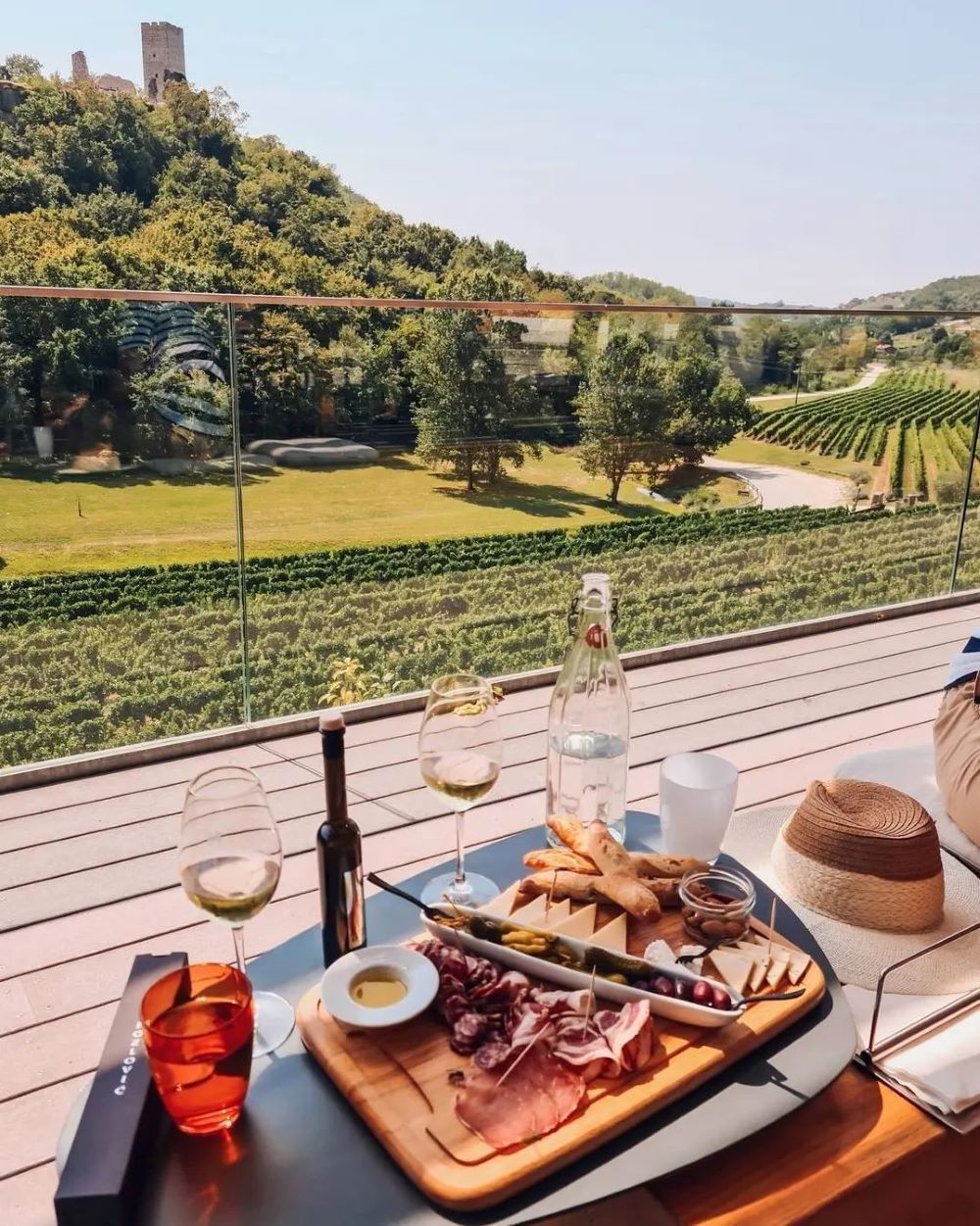
In the realm of wine travel, Croatia shines as an under-explored destination with a wealth of vinous treasures waiting to be uncovered.
From the historic vineyards to the modern winemaking techniques, every step of your journey through Croatia’s wine regions promises a unique and unforgettable experience.
By following these expert tips, you’ll be well-equipped to savor the best of what Croatian wine travel has to offer.
Wine tours and cooking classes
Wine tourism in Croatia is on the rise, and wineries are more welcoming than ever to visitors. Many wineries offer guided wine tours of their vineyards and cellars, providing an intimate look at the winemaking process.
Don’t miss the chance to engage with Croatian wine and cooking classes or passionate winemakers eager to share their stories and insights. Tasting rooms offer the perfect opportunity to sample a diverse array of wines, from fresh and zesty whites to age-worthy reds.
Wine festivals and events
For those looking to embark on a wine adventure through the Croatian regions, it’s advisable to plan the journey during the annual wine festivals that showcase the best of local wines.
Festivals like Vinistra in Istria, Vinart Grand Festival in Zagreb, the days of open cellars through the year, or the Festival of Graševina and Festival of Traminer in Slavonia offer visitors a chance to taste a diverse array of wines while engaging with the vibrant local culture.
Find out more info about wine festivals in Croatia to plan your wine trip accordingly.
Food and wine pairing delights
A visit to Croatia wouldn’t be complete without indulging in its delectable cuisine in a local restaurant or a gourmet experience in some of the Michelin-starred Croatian restaurants.
Local dishes are often crafted to complement the flavors of the region’s wines. If you enjoy sailing in Croatia, we have a carefully selected (and tested) list of top seaside restaurants for a truly immersive gourmet experience.
From seafood delicacies along the coast to hearty meat dishes in the interior, there’s a perfect pairing for every wine you encounter.
Be sure to ask for recommendations at the wineries or local restaurants to enhance your gastronomic experience.
Travel tips and etiquette
While planning your Croatian wine adventure, there are a few travel tips and etiquette guidelines to keep in mind.
Many wineries operate on appointment-only schedules, so be sure to reach out in advance. It’s also considered courteous to purchase a bottle or two after a tasting, as it supports local producers and ensures their sustainability.
If you intend to explore cultural attractions during your stay, these online platforms for reserving private local guides in Croatia can be of assistance.
Don’t forget to use these travel apps to help you navigate Croatia like a pro.
The joy of exploring indigenous varieties
One of the most exciting aspects of Croatian wine travel is the opportunity to explore indigenous grape varieties that you might not find anywhere else (except on our web shop) :).
The aforementioned Plavac Mali or Grk are a prime example.
Finding accommodation
To fully immerse yourself in the world of Croatian wine, consider staying at accommodations that offer vineyard views or are located in close proximity to wineries.
If you’re looking for affordable accommodations in Croatia, these online platforms can assist you in booking them.
Many boutique hotels and accommodations provide a charming ambiance, allowing you to wake up to breathtaking vistas of vine-covered hills and sun-soaked landscapes.
Before planning your stay, make sure to check out our carefully selected list of the best accommodation options available, sorted in different categories:
Conclusion
Embarking on a wine journey through Croatia is an enchanting experience that immerses you in centuries-old traditions, stunning landscapes, and a diverse array of wines.
From the sun-kissed vineyards of Dalmatia to the rolling hills of Istria, Croatia’s wine regions offer a remarkable blend of history and innovation.
By exploring indigenous grape varieties and visiting top Croatian wineries, you’ll uncover the heart and soul of Croatia’s wine culture, leaving you with cherished memories and a newfound appreciation for its wines.
*Please note that some booking links are set up through affiliate programs, meaning Wine & more gets referral credits if you book these accommodations via our links.
Our Expertise
Valentina Silovic is an experienced sommelier and content creator with over a decade of expertise in the wine industry. She has worked in various settings, from luxurious hotels to cozy wine bars, and has explored the grandest wineries in Croatia, tasting and discussing an uncountable number of bottles along the way.
Want to meet the team behind Wine & more, seek recommendations, and discover in-depth insights into our product testing and reviews? Click here now!
You Might Also Like
- Croatian Wine – Everything You Need To Know
- Essential Guide To Croatian Wineries & Beyond
- Guide to Exclusive Vineyards to Visit in Croatia
- 10 Best Croatian Wine Hotels and Winery Accommodations
- The Ultimate Guide to Croatian Wine Festivals and Events
- Croatian Decanter Award-Winning Wines: Ultimate Guide





